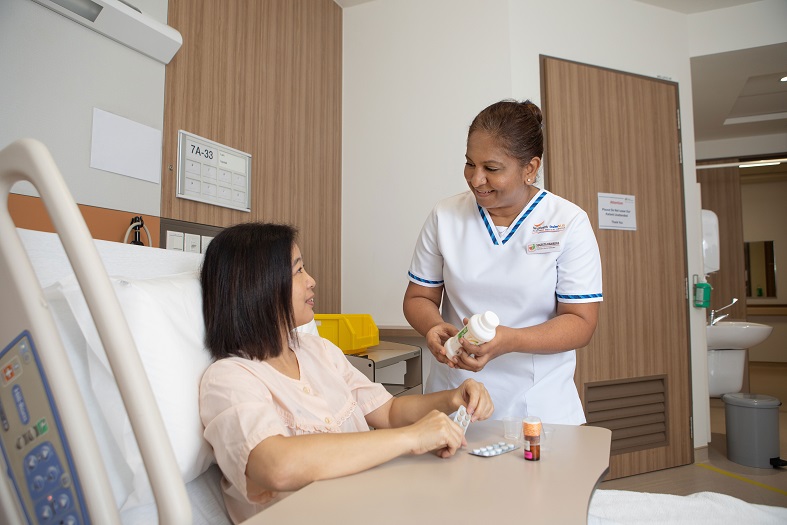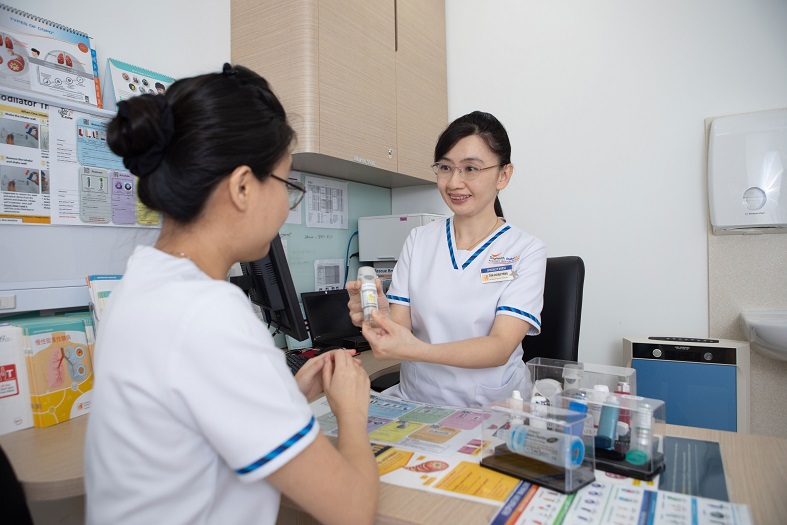These nurses kick-started innovation and quality improvement projects to enhance patient care and workflow processes.
Greater efficiency through innovation
Assistant Director of Nursing Lee Ang Noi, Senior Nurse Manager Teo Kai Yunn and Nurse Clinician Wang Xia may be from different hospitals — KK Women’s and Children’s Hospital (KKH), Singapore General Hospital (SGH), and Changi General Hospital (CGH) respectively — but they are united in addressing a key issue: tracking assets more efficiently in their respective hospitals.
Every hospital manages a significant number of assets, ranging from medical equipment such as electrocardiograph machines (ECGs) to trolleys and infusion pumps used to deliver medications to patients intravenously. Sometimes, healthcare workers maynstruggle to locate required equipmentnand therefore must do frequent inventory checks. “It is labour-intensivento do manual inventory checks as nurses must spend time walking from one wardnto another,” Ang Noi explained. “The time needed for this task could be better used caring for patients.” “This is also an issue that affects other colleagues such as our biomedical engineers, who manage some of these assets and conduct routine maintenance,” shared Wang Xia.
More importantly, the delivery of medicines could be affected during patient transfers. Elaborating, Kai Yunn said, “When a patient is transferred from one ward to another, the infusion pump is moved with them. Once the patient arrives, the receiving ward nurses are required to set-up their own pump to continue the medication therapy. Switching to a new pump would mean an interruption to the delivery of the intravenous medication and nurses need to perform diligent checks to ensure the pump is set up correctly. As some medicines are sensitive to interruptions, the pumps need to be changed in the shortest time possible.”
To address this issue, Ang Noi, Kai Yunn, Wang Xia and a team of nurses from across SingHealth worked with a vendor to develop an asset tracking system with a dashboard that tracks each piece of equipment in real-time, including its location and movement, the usability of the equipment, utilisation rates as well as the quantity available for use. These specifications took into account feedback and input from colleagues on the ground on what information would be useful and were incorporated into the finished product.
With the dashboard developed, the project team is now tackling the next technical hurdle. Kai Yunn explained that each piece of equipment needs to be tagged so that devices mounted on the ceiling can read its location. The difficulty arises when the equipment is placed too close to another zone. “For example, if available equipment is placed too near to a zone marked as ‘faulty’, the system may pick it up as faulty on the dashboard.” Kai Yunn and her team at SGH are now working with the vendor to improve the precision of the location reader.
Each hospital has also begun adapting its processes in preparation for the system to be rolled out at selected departments for testing. Preliminary feedback from staff has been positive, with many commenting how easy it was now to locate equipment.
The system offers other benefits. For instance, it eliminates the need for accompanying paperwork and management of loaned pumps between wards. It also removes the need to swop pumps when patients transfer wards, thus eliminating potential patient safety risks.
“This project was a collaboration between nursing and multiple other departments, including Biomedical Engineering, Department of Future Health System, Integrated Health Information Systems and the SGH Emergency Medicine and Major Operating Theatres, where the project was first piloted,” said Kai Yunn. The eventual goal is to implement it across all SingHealth hospitals.
All three nurses believe in the need for such projects to continuously improve patient care and workflow efficiency. “Leveraging advances in technology, we can make meaningful improvements in care delivery for both nurses and patients,” said Wang Xia, who is currently pursuing a Fellowship in Nursing Transformation.
Empowering patients to manage their conditions effectively

Traditionally, patients rely on nurses for all aspects of their care during their hospital stay, including taking their medications. However, as patients are increasingly more knowledgeable of their own medical conditions and medications management, Assistant Nurse Clinician Sugeeta Ramadas and her team believe that patients can be empowered to manage their conditions. This starts with them taking their medications independently and correctly during their short stay in the community hospital.
With that aim in mind, Sugeeta and her team from Outram Community Hospital (OCH), part of SingHealth Community Hospitals (SCH), embarked on a project called Self-Administration of Medications, or SAM for short. For a start, SAM targets patients who have undergone total knee replacement (TKR) surgery and encourages them to begin taking their medicines independently while they are still in the hospital.
“We chose to pilot this programme with TKR patients because they are a group of patients who are generally independent in managing their activities of daily living. We do not want to remove that ability from them just because they are in a hospital,” Sugeeta explained. Empowering patients to manage their conditions and medications while they are in hospital will enable them to successfully and independently manage their own care when they transit home post-discharge.
Sugeeta and her multi-disciplinary team of doctors, nurses and pharmacists began working on this project in late 2022. As the nursing co-lead with Nurse Clinician Tan Pei Jie, she was involved in all aspects of the project, from initial discussions to creating mindmaps to training the nurses on the new workflow.
The programme also strengthens the patient’s medication knowledge at every step. The team first ensures that patients have sufficient knowledge about their medications before enrolling them into SAM. Nurses then continue to provide indirect supervision to ensure that patients on SAM can manage their medications well.
With the new workflow developed for doctors, pharmacists and nurses, the team began to trial it in May this year on selected patients. The goal is to gradually expand this initiative to more patients who are assessed to be suitable in the future.
Improving nurses’ skills in administering inhalers

Inhaled therapy remains the mainstay treatment for patients with obstructive lung diseases. The effectiveness of medications is dependent on proper administration techniques. There are many different types of inhaler devices used in SKH such as pressurised metered dose inhalers (pMDIs), Ellipta and Respimat. Nurses therefore find it challenging to remember the different techniques used for each.
Assistant Nurse Clinician Toh Hsiao Peng, a respiratory specialty nurse, observed that nurses often spend time searching for a user guide for each type of inhaler. “They also struggle to demonstrate the correct way to use the inhaler,” Hsiao Peng shared. Improper use of the inhaler may result in poorly controlled symptoms and even frequent hospital readmissions.
To tackle this, Hsiao Peng and her team came up with The Art of Inhaler, a quality improvement project to make it easier for nurses to correctly administer the different types of inhalers available at SKH.
Through a survey, they found out that nurses lacked confidence in teaching patients how to use the inhalers, especially because they did not have a reliable resource to guide them on administering the inhalers. As such, Hsiao Peng and her team worked to standardise inhaler administration techniques and design work instructions. They also created a series of videos and posters to guide nurses on how to use each type of inhaler. These posters were put up at all nursing stations for easy reference.
After developing these resources, one of the key challenges for the team was ensuring that everyone had access to the videos. So, Hsiao Peng turned to the nursing education team to incorporate the teachings in an e-learning module that nurses must complete as part of their competency checklist. Hsiao Peng’s team also conducts periodic audits to ensure that nurses are demonstrating the use of the inhalers correctly.
As a result, all the nurses surveyed reported feeling more confident when teaching patients how to use the inhalers. Their knowledge scores also increased significantly, from four to 100 per cent. Additionally, the videos were so well received that even doctors and pharmacists used them to learn the correct techniques.
In the future, Hsiao Peng hopes to share the educational videos with other SingHealth institutions and adapt them into patient education materials.
To read more stories of our extraordinary nurses, download the Singapore Health Special Nursing Supplement.
